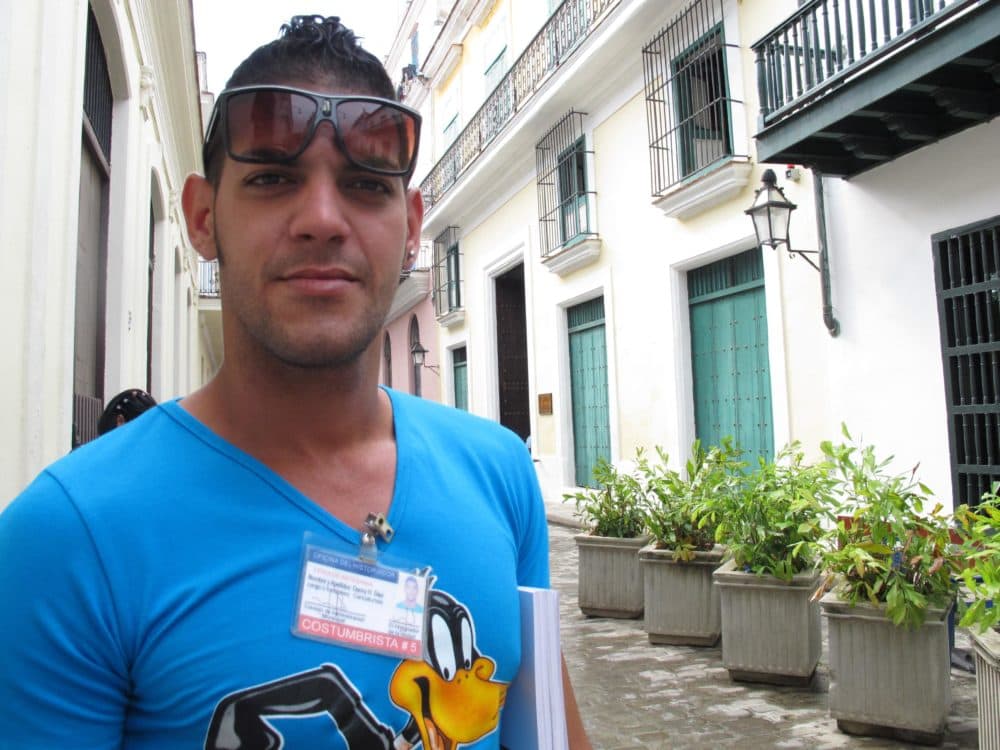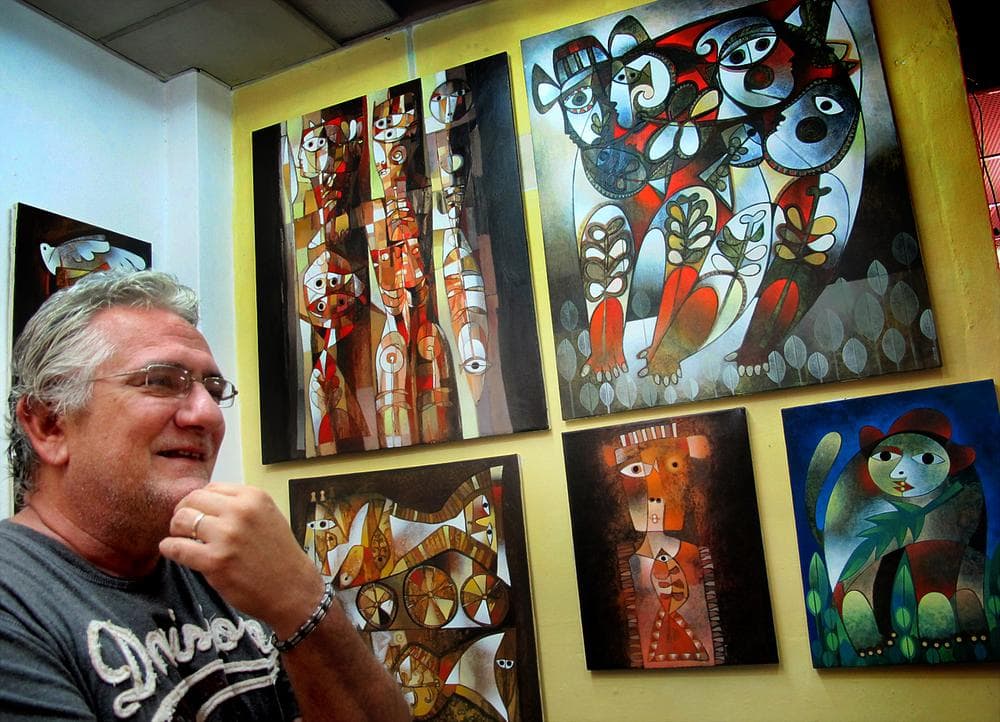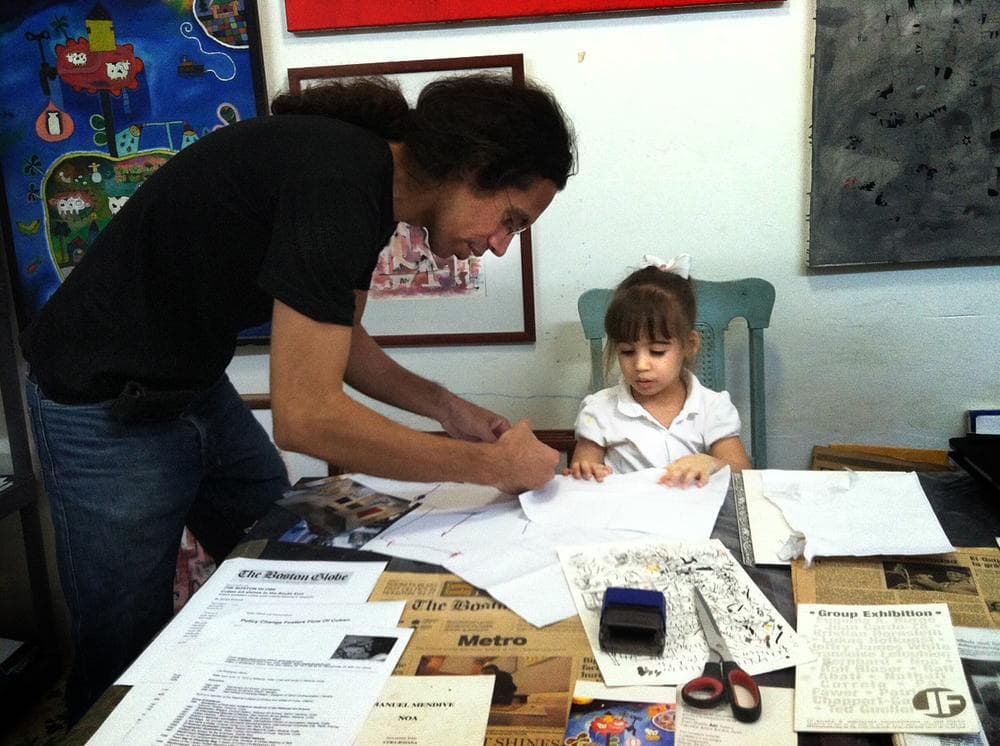Advertisement
Cuba Opens Through Art
Artists Pioneer Cuba's Changing Economy
ResumeIn the socialist island nation of Cuba things are changing.
WBUR’s Andrea Shea recently went on a person-to-person cultural tour — one of the few ways Americans can travel to Cuba — with a Boston-based art dealer who's taking advantage of loosening restrictions to get Cuban artists exposed to American collectors. She reports on how Cuban artists have attained a relatively privileged spot in Cuban society — a position that could shift because of competition in the country’s changing economy.
When Fidel Castro took power in 1959, Americans were terrified. The specter of communism was just 90 miles off the coast of Florida. But while U.S. anxiety was high outside Cuba, some fascinating social changes were under way inside. Castro had a utopian vision for the country. His aim was to take an aggressive approach to promoting education, science and all forms of culture.
Sixty-year-old Cuban painter Edel Bordon claims he wouldn’t be an artist if it hadn’t been for Castro’s Revolution. Surrounded by his work inside his home studio in Havana, Bordon recalls his impoverished childhood on a farm in the mountains. Silvia Wilhelm, a Miami-based Cuban-American with a U.S. license that allows her to organize people-to-people cultural tours, translates.
"Where he lived there was no electricity, no highways, no schools," Wilhelm translated. "So he started school when he was 9 years old, when the revolution triumphed and they made a school, and he was able to have a lot of possibilities to study all the way to his bachelor’s degree."
Bordon actually earned two art degrees, tuition-free, after 13 years of study. And he's been a professor at the San Alejandro School of Art in Havana for 20 years. That said, he’s quick to point out that the revolution wasn’t perfect and shouldn’t be thought of that way. Countless Cubans have been persecuted during Castro’s rule, basic freedoms have been denied, and most Cubans only earn the equivalent of $20 a month. But since that early period, artists have benefited from Castro’s ideals. They sit high on the socioeconomic ladder, wholeheartedly supported by both the Cuban government and the people.
This wasn’t just a result of Castro’s vision. In 1991, the Cuban leader was forced to respond to the fall of Soviet communism and its devastating impact on Cuba’s economy.
The Special Period
Industry in Cuba ground to a halt without the Soviet Union’s support. Fuel was scarce. Severe food rationing was imposed. Many Cubans fled, artists included. The crisis forced Castro to usher in what’s known as the Special Period.
In a move to save his now-isolated island nation, the socialist leader turned to the U.S. dollar and the promise of tourism. He also recognized art as a significant export. Painters, print makers and sculptors were granted the right to sell their work, and the international art market came calling — including the U.S. because of an exception to the U.S. trade embargo.
"Art in Cuba is extremely important culturally, but also since the '90s it’s been one of the few things that Cubans have been able to do as private enterprise," explained Boston gallery owner Michelle Wojcik, who deals exclusively in Cuban art.
To put this in perspective, just about everything in Cuba is owned and run by the government, so being allowed to sell anything has been rare. When asked if it's accurate to say Cuban artists have been privileged since then, Wojcik says they have.
"I mean, if you think about the fact that they can travel, they can conduct business directly, and they can buy cars, yes, they have had a certain amount of privilege," she said.
In Cuba, Artists Thrive
Forty-two-year-old painter Luis Rodriguez, also known as NOA, is another one of Michelle's artists and because of his status, he was free to travel to New York and Boston in 2011.
Rodriguez is a leader among the new generation of Cuban artists who've been able to capitalize on what many here call an "inverted pyramid" — where an artist can make a living in his or her chosen field, but a lawyer or doctor might end up driving a cab.

Rodriguez lives in a tiny apartment with his wife and 3-year-old daughter Cecilia. Collectors in Switzerland and the U.S. follow his work. Now he’s thrilled to welcome a group of Wojcik’s American clients to the Havana studio he’s been renovating for 10 years.
"You must be feeling like I was feeling in the U.S., like another planet. It's crazy," Rodriguez said.
Rodriguez says he’s very optimistic about Cuba’s future. Just this week, the Cuban government lifted two long-despised travel restrictions, including the need for an exit visa, making it easier for all Cubans to leave for vacation, for work or possibly for good.
"I am 42 years old and I’ve never seen before a change like that because it was a difficult thing, a hard thing for Cubans to go out because you need so many papers and money," Rodriguez explained.
Raul Castro, former leader Fidel Castro’s younger brother, has been rolling out a number of reforms. Over the past two years he’s created 181 job categories allowing a limited number of people to operate small, independent businesses, like beauty salons and street stalls.
Fewer Restrictions Create Competition
For 51-year-old painter Orestes Gaulhiac the changes are a mixed blessing. With interpreting help from Wilhelm, Gaulhiac explained how the reforms in his country mean more Cuban artists are getting into the game.

"With the new changes in Cuba, the new possibilities to get licenses, a lot of the artisans are occupying a lot of that space, so they’re expanding, the artisans."
The flood of artists means less studio space. Gualhiac recently lost his old studio downtown and had to move into his mother's place in the Vedado section of Havana.
And even with more competition and more freedom, the lack of materials is a major obstacle for Cuban artists. The 50-year-old U.S. trade embargo has made high quality paint and paper scarce.
"This is a problem when art is your living," Wojcik explained.
Wojcik does her part by always bringing materials from the U.S. for her artists.
Art As Nourishment
And there are plenty more paradoxes: Art school is free, but taxes are high once you start working. The Cuban artists I spoke with say they are able to express themselves through their work, but others keep defecting, citing greater personal freedoms and opportunities. In fact, two of Wojcik’s artists traveled to the U.S. in 2011 and never returned to Cuba.

Rodriguez acknowledges that supporting and promoting the arts and culture is good for the Cuban government’s image. And yes, it's better than say, highlighting the state's notorious human rights record.
The artist truly believes music, film, theater and all art forms help Cuban society. Everyone’s an artist here, he says, from a very young age — and art is a kind of nourishment and salvation, especially when times are extra hard, like when there’s a hurricane.
"People are looking for food to have during the hurricane, but they are also looking to have a radio at least to listen to music when the hurricane is there, and if possible to dance," he said.
And right now 11 million Cubans are looking forward, speculating about the future and what a post-Castro Cuba might look like. Plenty of people are wary of change coming too fast to a society not accustomed to a market-based economy. For now, though, Rodriguez says painting is his life and he’ll continue to capture the surreal world he lives in on canvas. The artist also wonders if his young daughter, Cecilia, might follow in his footsteps. As we talked, the toddler was hunched over a chair, grasping a colored marker in her hand, emulating her father.
"Cuba Opens Through Art" was edited by Martha Little with online editing by Abby Elizabeth Conway, multimedia production by Jesse Costa, and production assistance from Katie Broida. The technical engineers were George Hicks, Missy Webb, Mike Garth, Paul Vaitkus, and JT Trout.
